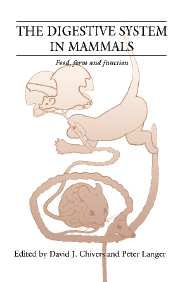Book contents
- Frontmatter
- Contents
- List of contributors
- Preface
- Part I Introduction
- Part II Food
- 5 Foods and the digestive system
- 6 Classification of foods for comparative analysis of the gastro-intestinal tract
- 7 The ‘carnivorous’ herbivores
- 8 Nutritional ecology of fruit-eating and flower-visiting birds and bats
- 9 Herbivory and niche partitioning
- 10 Taste discrimination and diet differentiation among New World primates
- 11 Potential hominid plant foods from woody species in semi-arid versus sub-humid sub-tropical Africa
- Part III Form
- Part IV Function
- Part V Synthesis and perspectives
- Index
10 - Taste discrimination and diet differentiation among New World primates
Published online by Cambridge University Press: 18 March 2010
- Frontmatter
- Contents
- List of contributors
- Preface
- Part I Introduction
- Part II Food
- 5 Foods and the digestive system
- 6 Classification of foods for comparative analysis of the gastro-intestinal tract
- 7 The ‘carnivorous’ herbivores
- 8 Nutritional ecology of fruit-eating and flower-visiting birds and bats
- 9 Herbivory and niche partitioning
- 10 Taste discrimination and diet differentiation among New World primates
- 11 Potential hominid plant foods from woody species in semi-arid versus sub-humid sub-tropical Africa
- Part III Form
- Part IV Function
- Part V Synthesis and perspectives
- Index
Summary
An integrative approach to feeding adaptations should consider taste discrimination as one of the first steps, functioning to assess the quality of food before it is processed in the gut. My recent work with Neotropical primates has shown that, in addition to taste thresholds, the study of above-threshold responses for different chemicals allows a better understanding of subtle differences in food choices among species. Although they cannot be considered as exclusively depending on the taste channel, these global taste responses may shed light on an important component that, together with gut differentiation, aids the animal in coping with the biochemical environment.
The data presented here were obtained on primate species belonging to the family Callitrichidae, namely marmosets (Cebuella pygmaea and Callithrix spp.), tamarins (Saguinus oedipus and Leontopithecus spp.) and Goeldi's monkey (Callimico goeldii). Each of these small-bodied primates (120 g to 710 g) eats fruits, nectars and plant exudates (mostly gums) in addition to insects, but their diet may differ to a large extent in the proportion of these plant food categories, marmosets being the most gummivorous callitrichids (Snowdon and Soini, 1988; Soini, 1988; Stevenson and Rylands, 1988; Rylands, 1989). All these species feed opportunistically on gums that are released from branches and tree trunks, presumably as a consequence of damage inflicted to the tree by xylophagous insects, but only marmosets have a specialized dentition allowing them to gnaw barks in order to stimulate exudate flow in a relatively predictable manner.
- Type
- Chapter
- Information
- The Digestive System in MammalsFood Form and Function, pp. 150 - 165Publisher: Cambridge University PressPrint publication year: 1994
- 14
- Cited by



